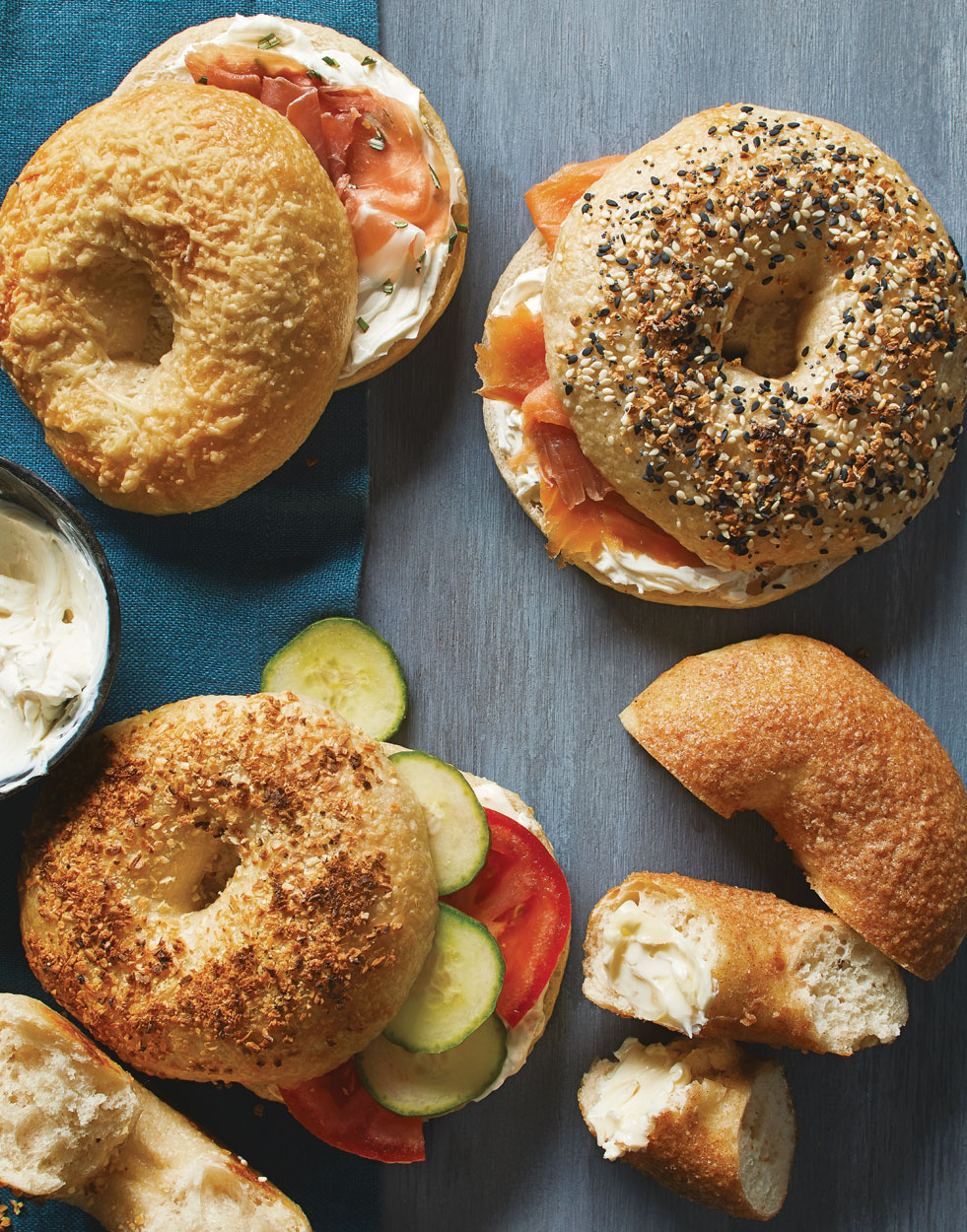
Breakfast / Brunch
Homemade Bagels
True New York bagels are a thing of beauty. Boiled then baked, they’re dense but not too dense, with glossy, crackly crusts and soft insides. But NYC isn’t the only place to get decent bagels — they’re one of the simplest breads to make at home.
Smoked salmon and cream cheese or a smoked salmon cream cheese spread makes a great choice for full-flavored Everything bagels. Asiago bagels just beg for a slice of ham or prosciutto and maybe an egg. A sprinkling of rosemary adds a lovely herbal note, too. A fairly neutral veggie cream cheese, with cucumber, avocado, and/or tomato slices, pairs nicely with the Onion topping. And for Cinnamon-Sugar bagels, toasting is deemed a requirement along with a nice slather of butter. Or keep it simple and just add a schmear of plain cream cheese.
Ingredients
WHISK:
COMBINE:
HEAT:
DIP:
FOR CINNAMON-SUGAR BAGELS, COMBINE:
HOW TO TOP BAGELS
-
For most toppings, you’ll simply dip the rounded side of each bagel in your topping of choice and place them back on baking sheets.
-
For Asiago cheese, to make sure the cheese adheres, sprinkle the Asiago over each bagel. (You’ll also want to broil Asiago-topped bagels after baking them, to help the cheese brown.)
-
For cinnamon-sugar butter, grab clumps of the “paste,” press and flatten the clumps, then arrange several on top of boiled bagels to cover before baking them.
Instructions
Whisk together flour, salt, and yeast in the bowl of a stand mixer.
Combine 2¼ cups water and honey, then add to flour mixture.
Mix dough on low speed with a dough hook until ingredients come together, then increase speed to medium-low and knead dough until smooth and elastic. (Bagel dough should be quite stiff and not at all tacky. If the mixer struggles to knead the dough, remove it from the mixer and finish kneading by hand.)
Coat the inside of a bowl with nonstick spray. Place dough in bowl, turn to coat, then cover with plastic wrap and let rise until doubled in size, about 2 hours.
Line two baking sheets with parchment; coat with nonstick spray.
Punch down dough; divide into 12 (about 4 oz.) pieces. Loosely cover dough with plastic wrap while weighing and shaping bagels.
Shaping Method 1: Shape each piece of dough into a ball. Poke a hole in the center and work dough to widen and smooth the hole until about 2-inches in diameter.
Shaping Method 2: Flatten each piece of dough; roll each into an 11-inch-long rope. Grasp one end of the rope in your palm, wrap the rope around the back of your hand, then overlap the ends of the rope by 1 inch. Squeeze the ends together, then gently roll squeezed ends to create a bagel with even thickness; set on prepared baking sheet.
Cover baking sheets of shaped bagels loosely with plastic wrap and refrigerate overnight.
Remove bagels from refrigerator; add one to a bowl of cold water. (If it floats, they’re ready to boil. If it sinks, let bagels continue to rise at room temperature, 15–20 minutes, then test again. Repeat procedure until it floats.)
Meanwhile, preheat oven to 500°. Heat 4 qt. water and baking soda in a pot to a boil over medium-high. Place each topping in a separate bowl.
Boil bagels, a few at a time, 45–60 seconds per side, then transfer to baking sheets lined with parchment.
Dip rounded side of bagels in toppings and place back on baking sheets. (For Asiago, sprinkle cheese over rounded side of bagels.)
Bake bagels until golden and they sound hollow when tapped on the bottoms, about 11 minutes. (For Asiago, after baking, broil bagels on high until golden, 1–2 minutes.)
For cinnamon-sugar bagels, combine butter, sugar, flour, cinnamon, salt, and baking powder with a fork until a paste forms with no streaks of butter. Grab clumps of the paste with your fingers and press it into flat-ish pieces and set on top of boiled bagels to cover tops. Bake as per other bagels.
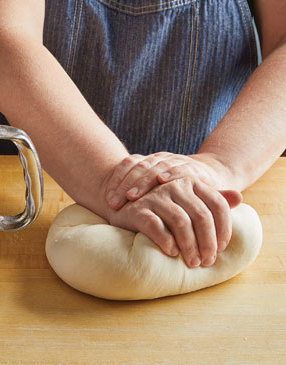
Because bagels rely on bread flour, which has a higher protein content, the dough tends to be very stiff (yet supple, with a satiny but not tacky feel) and takes a bit more time and effort to develop the gluten.

Because bagels rely on bread flour, which has a higher protein content, the dough tends to be very stiff (yet supple, with a satiny but not tacky feel) and takes a bit more time and effort to develop the gluten.
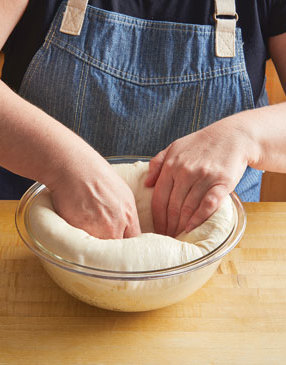
Since bagels are meant to be chewy and denser than other breads, punching down the dough helps to deflate it and remove air bubbles so you can easily divide and form the dough into bagel shapes, using your preferred method.

Since bagels are meant to be chewy and denser than other breads, punching down the dough helps to deflate it and remove air bubbles so you can easily divide and form the dough into bagel shapes, using your preferred method.
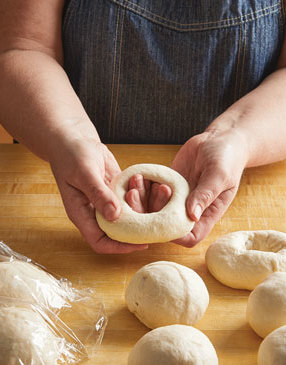
Shaping Method 1: Roll about 4 oz. of dough into a smooth round ball, making sure the seam on the bottom disappears. Poke a hole in the middle and stretch it into a ring (until the hole is about 2 inches in diameter). Adjust the shape as needed.

Shaping Method 1: Roll about 4 oz. of dough into a smooth round ball, making sure the seam on the bottom disappears. Poke a hole in the middle and stretch it into a ring (until the hole is about 2 inches in diameter). Adjust the shape as needed.
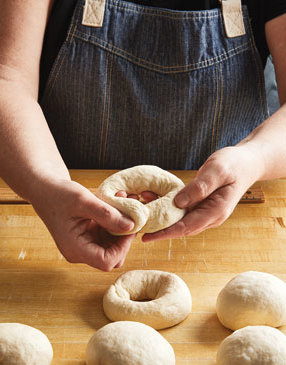
Shaping Method 2: Roll about 4 oz. of dough into an 11-inch-long rope. Overlap the ends of the rope by 1 inch and pinch them together. Roll the seam back and forth on your work surface to make sure the two ends are sealed.

Shaping Method 2: Roll about 4 oz. of dough into an 11-inch-long rope. Overlap the ends of the rope by 1 inch and pinch them together. Roll the seam back and forth on your work surface to make sure the two ends are sealed.
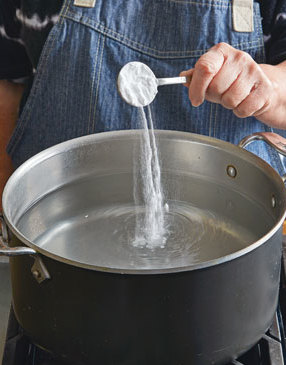
Traditionally, bagels are boiled with lye or barley malt extract to help the crusts brown, give them distinct flavor, and affect the water’s alkalinity. These days, baking soda is often substituted for lye.

Traditionally, bagels are boiled with lye or barley malt extract to help the crusts brown, give them distinct flavor, and affect the water’s alkalinity. These days, baking soda is often substituted for lye.

Bagels are boiled to help set the crust before baking (it also reactivates the yeast). Turn the bagels once so both sides “sit” in the boiling water. And note, the longer the boil, the thicker and chewier the crust will be.

Bagels are boiled to help set the crust before baking (it also reactivates the yeast). Turn the bagels once so both sides “sit” in the boiling water. And note, the longer the boil, the thicker and chewier the crust will be.
Nutritional Facts
Nutritional Facts
Per plain bagel
Calories: 295
% Daily Value*
Total Fat 1g 1%
Saturated Fat 0g 0%
Cholesterol 0mg 0%
Sodium 482mg 20%
Carbs 60g 20%
Protein 10g
*Percent Daily Values are based on a 2,000 calorie diet.